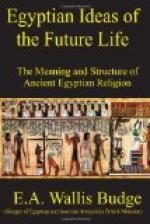Now Osiris became not only the equal of R[=a], but, in many respects, a greater god than he. It is said, that from the nostrils of the head of Osiris, which was buried at Abydos, came forth the scarabaeus [Footnote: See von Berginaun in Aeg Zeitschrift, 1880, p. 88 ff.] which was at once the emblem and type of the god Khepera, who caused all things to come into being, and of the resurrection. In this manner Osiris became the source and origin of gods, men, and things, and [Illustration: The soul of R[=a] (1) meeting the soul of Osiris (2) in Tattu. The cat (i.e., R[=a]) by the Persea tree (3) cutting off the head of the serpent which typified night.] the manhood of the god was forgotten. The next step was to ascribe to him the attributes of God, and in the XVIIIth and XIXth dynasties he seems to have disputed the sovereignty of the three companies of gods, that is to say of the trinity of trinities of trinities, [Footnote: Each company of the gods contained three trinities or triads.] with Amen-R[=a], who by this time was usually called the “king of the gods.” The ideas held concerning Osiris at this period will best be judged by the following extracts from contemporary hymns:—
“Glory [Footnote: See Chapters of Coming Forth by Day (translation), p. 11.] be to thee, O Osiris, Un-nefer, the great god within Abtu (Abydos), king of eternity, lord of everlastingness, who passest through millions of years in thy existence. The eldest son of the womb of Nut, engendered by Seb the Ancestor [of the gods], lord of the crowns of the South and of the North, lord of the lofty white crown; as prince of gods and men he hath received the crook and the whip, and the dignity of his divine fathers. Let thy heart, which dwelleth in the mountain of Ament, be content, for thy son Horus is stablished upon thy throne. Thou art crowned lord of Tattu (Busiris) and ruler in Abydos.”
“Praise [Footnote: Ibid., p. 34.] be unto thee, O Osiris, lord of eternity, Un-nefer, Heru-Khuti (Harmachis) whose forms are manifold, and whose attributes are great, who art Ptah-Seker-Tem in Annu (Heliopolis), the lord of the hidden place, and the creator of Het-ka-Ptah (Memphis) and of the gods [therein], the guide of the underworld, whom [the gods] glorify when thou settest in Nut. Isis embraceth thee in peace, and she driveth away the fiends from the mouth of thy paths. Thou turnest thy face upon Amentet, and thou makest the earth to shine as with refined copper. The dead rise up to see thee, they breathe the air and they look upon thy face when the disk riseth on its horizon; their hearts are at peace, inasmuch as they behold thee, O thou who art eternity and everlastingness.”
In the latter extract Osiris is identified with the great gods of Heliopolis and Memphis, where shrines of the Sun-god existed in almost pre-dynastic times, and finally is himself declared to be “eternity and everlastingness”; thus the ideas of resurrection and immortality are united in the same divine being. In the following Litany the process of identification with the gods is continued:—




